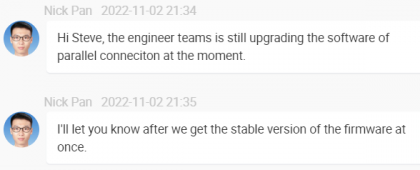Grid tied inverters is another word for current injection into an existing sine wave.
You need to be "ahead" of the sine wave a little and with higher voltage in order to pump the power in.
Now imagine this scenario:
MY AC (3000 watt) is running/fridge/freezer/computers/internet stuff
Total house load is 4000 watt.
I have 6000 watt panels connected to my LP inverter, I have batteries and they are already 96% full and I have 2000 watt of grid tie inverters hooked up.
8000 watt PV, only 4000 watt load so exporting 4000 watt into the grid.
Grid disappears.
LP takes over and generates microgrid while disconnecting from the grid.
It takes 2000 watt from the 6000 PV panels hooked up and together with 2000 of grid tied inverters keeps everything running.
there is a load of 4000 that is now equally split between LP & grid tied inverter (AC coupled)
Now my thermostat tells my AC it is cold enough and switches off the 3000 watt load.
Rest of the house is only using 1000 watt and the grid tied AC coupled inverters are making 2000 watt.
What happens in the (milli)seconds the 3000 watt load is switched off ?
Where is the 2000 watt from the grid tied inverters going ?
the LP will eventually switch frequency to tell the grid tie inverters to power down.
This is the graph from the LP installation manual:
View attachment 118926
It will take several seconds before the LP changes freq, and than the grid tied inverters lower their output.
It can not calculate what frequency it will have to change to in order to balance the load with the grid tied inverters.
It will just taper down and adjust, in the mean time the grid tie inverters try to get rid of their power by injecting it into the micro grid from the LP.
If the batteries would be somehow drained to eg 90% the power could be used to charge the batteries, gently find the right frequency and balance things out.
That was the remark I tried to make earlier.
My other hybrid inverter (megarevo) has AC coupled to the generator hookup of the inverter.
That way if it detects the AC coupled input vs the load is out of balance it will open the relay -> grid tied inverters will not see grid any more -> anti-islanding -> stop producing in milliseconds.
Inverter can change frequency to eg 62 hz, close relay, after 300 seconds the grid tie inverters will try and help again , lower frequency to 61.5 and _slowly_ find the balance again.
It is just another way of thinking.
This is (afaik) the same way the SOL-ARK takes care of this.
Long story, I hope I tried to explain it a bit better with the above example.
If not, let me know.






